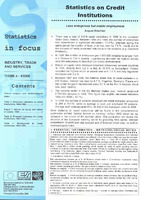Statistics in Focus. Statistics on Credit Institutions Less enterprises but stable employment.

Working Document
Συγγραφέας
EU Commission
Ημερομηνία
2000-05-15Προβολή/
Θεματικές επικεφαλίδες
Economic and Financial Affairs ; StatisticsΠερίληψη
There was a total of 8 618 credit institutions in 1998 in the European Union (excl. Ireland). Between 1994 and 1998, the number of enterprises has experienced a significant decrease (-12.9 %), whereas during the same period the number of local units has risen by 7.9 %, mainly due to the inclusion of newly privatised institutions in the statistics (e.g. Deutsche Postbank).
> In 1998, the number of enterprises per 1 000 000 inhabitants ranged from 4 in Greece to 114 in Austria. Luxembourg recorded the highest density with 209 enterprises for less than 0.5 million of inhabitants.
> Return on equity ratios displayed important differences between countries in 1998, ranging from 3.2% in Italy to 25.4% in Switzerland. Finland recorded the highest return on assets ratio with 1.1 % and Italy registered the lowest with 0.3 %.
> Between 1997 and 1998, the balance sheet total of credit institutions in EU-15 (excl. Ireland) has risen by 8.7 %. Together, Germany, France and the United Kingdom represented about 67 % of the EU-15 balance sheet total (excl. Ireland).
> The banking sector in the EU Member States (excl. Ireland) employed 2 704 034 persons in 1998. This figure has slightly decreased between 1994 and 1998 (-0.7%). > In 1998, the number of persons employed per credit institution amounted
to 314 in EU-15, while in average a local unit employed 13 persons. Average staff costs equalled ECU 48 934 in the European Union in 1998. More statistics on credit institutions will be found in the comprehensive publication entitled 'Special feature on banking', edition 2000 which will be released in the course of the summer 2000. This publication will review the situation of the European banking sector by providing time series, detailed presentation of profit and loss account and of balance sheet data, as well as methodological notes.
